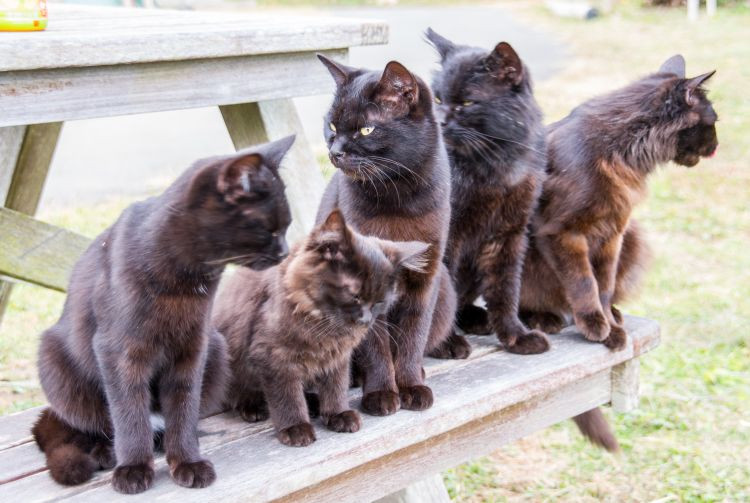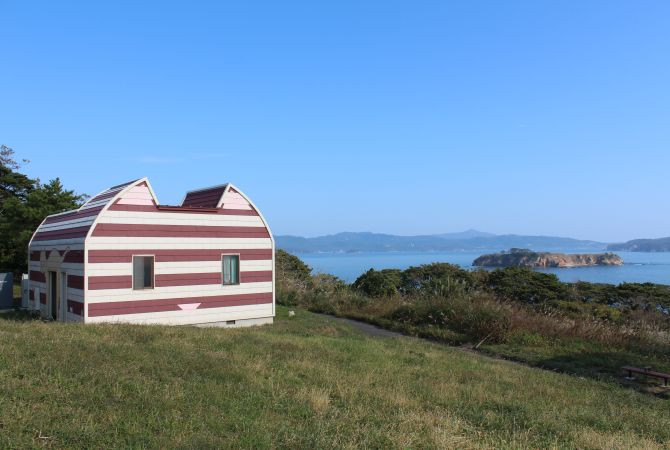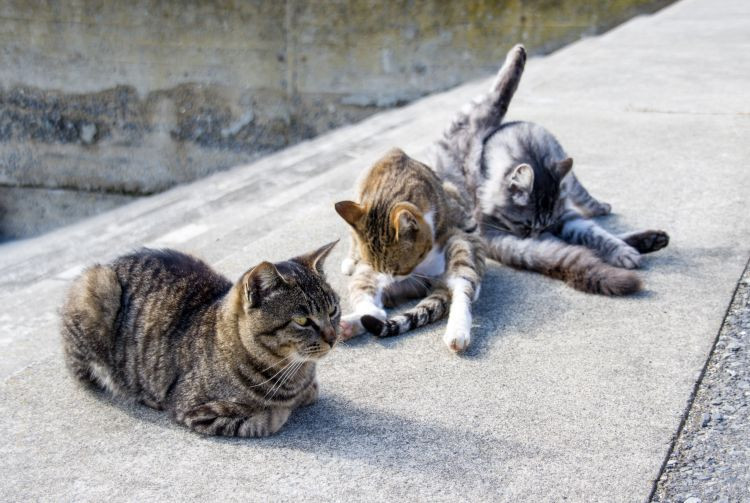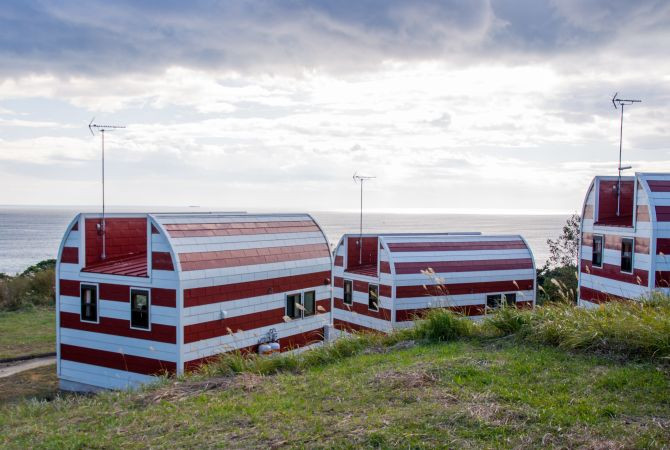Cat Island Tourism offers a unique and heartwarming travel experience that combines stunning natural beauty with the undeniable charm of feline companions. SIXT.VN can help you plan your dream vacation to explore these charming destinations and discover the allure of these feline-inhabited havens. Embark on an unforgettable journey filled with relaxation, cultural experiences, and countless adorable cat encounters, and also, don’t forget the amazing island exploration and feline adoration.
1. Understanding the Allure of Cat Island Tourism
What exactly is cat island tourism and why are these destinations becoming increasingly popular among travel enthusiasts?
Cat island tourism refers to traveling to islands where the cat population significantly outnumbers the human residents. These islands have become havens for felines, often due to historical reasons like pest control or fishing industry needs. The appeal lies in the opportunity to witness these adorable creatures living freely in a natural environment, offering a unique and heartwarming travel experience. The charm of these islands, which blend natural beauty with feline companionship, makes them must-visit destinations for animal lovers.
1.1. Historical Context and Evolution
How did cat islands come to be and what factors contributed to their feline-dominated status?
Many cat islands originated due to historical circumstances. Cats were often brought to these islands to control rodent populations, especially in areas dependent on fishing or silk production. Over time, the human population decreased, leaving the cat population to thrive. The most well-known cat islands like Tashirojima in Japan serve as examples. According to research from the Japan National Tourism Organization in 2023, islands that introduced cats for pest control saw a significant increase in cat populations over several decades.
1.2. The Cultural Significance of Cats
What is the cultural importance of cats in these locations, and how does it contribute to tourism?
In many cultures, cats are revered as symbols of good luck, prosperity, and protection. This reverence often translates into a supportive environment for cats on these islands, attracting tourists who appreciate the cultural significance and the unique experience of interacting with these revered animals. The cultural narratives surrounding cats create a deeper connection for visitors, enhancing the overall appeal of cat island tourism.
 Cats resting on a stone wall in Japan
Cats resting on a stone wall in Japan
2. Top Cat Island Destinations Around the World
Which cat islands are considered the most popular and what unique experiences do they offer to tourists?
Some of the most popular cat islands include Tashirojima (Japan), Aoshima (Japan), and various smaller islands in Greece and the Caribbean. Each destination offers distinct experiences, from interacting with friendly cats in serene villages to exploring historical sites amidst a feline-filled landscape. Visiting cat islands provides a one-of-a-kind travel experience that appeals to both cat lovers and adventure seekers.
2.1. Tashirojima, Japan: The Original Cat Paradise
What makes Tashirojima a must-visit destination for cat lovers and what are its key attractions?
Tashirojima, also known as Cat Island, is one of Japan’s most famous cat islands. Cats here outnumber humans, and they are well-cared for by the locals. Key attractions include the Cat Shrine, Manga Island, and the opportunity to wander through the island’s villages, interacting with friendly felines at every turn. According to a 2022 report by the Miyagi Prefectural Government, Tashirojima attracts thousands of tourists annually, contributing significantly to the local economy.
2.2. Aoshima, Japan: A Feline-Dominated Haven
What are the unique aspects of Aoshima that distinguish it from other cat islands?
Aoshima is another Japanese island where cats reign supreme. With very few human residents, cats roam freely, creating a surreal environment. Visitors can enjoy feeding and playing with the cats, exploring the island’s natural beauty, and experiencing a peaceful retreat away from the hustle and bustle of city life. Aoshima offers a more remote and less tourist-driven experience than Tashirojima, appealing to those seeking tranquility and authentic interactions with the feline inhabitants.
2.3. Greek Cat Islands: Exploring the Aegean with Felines
Which Greek islands are known for their cat populations, and what cultural experiences do they offer?
Several Greek islands, particularly in the Cyclades, are known for their significant cat populations. Islands like Mykonos and Santorini feature charming villages where cats roam freely, blending seamlessly with the iconic white-washed architecture. Visitors can enjoy exploring historical sites, savoring local cuisine, and experiencing the vibrant culture while interacting with friendly felines. The Greek cat islands offer a unique blend of cultural immersion and feline adoration, making them popular destinations for tourists seeking both history and animal encounters.
2.4. Other Notable Cat Islands Around the Globe
Are there any lesser-known cat islands worth visiting, and what unique experiences do they provide?
Besides the famous destinations, there are several lesser-known cat islands around the globe that offer unique experiences. These include small islands in the Caribbean and various locations in Southeast Asia. These hidden gems often provide a more intimate and authentic experience, allowing visitors to connect with local communities and the feline inhabitants in a less touristy environment.
 Cats relaxing on a building in Japan
Cats relaxing on a building in Japan
3. Planning Your Purr-fect Cat Island Getaway with SIXT.VN
How can SIXT.VN assist in planning a memorable cat island vacation, and what services do they offer?
SIXT.VN offers comprehensive travel services to help you plan your perfect cat island getaway. From airport transfers and hotel bookings to guided tours and transportation, SIXT.VN ensures a seamless and enjoyable travel experience. With their expertise and local knowledge, you can explore these unique destinations with ease and comfort. SIXT.VN simplifies travel logistics, enabling visitors to focus on the joy of discovering cat islands and their charming feline residents.
3.1. Tailored Travel Itineraries
Can SIXT.VN customize travel itineraries to suit individual preferences for exploring cat islands?
SIXT.VN specializes in creating tailored travel itineraries that cater to your specific interests and preferences. Whether you’re interested in wildlife photography, cultural immersion, or simply relaxing with cats, they can design a personalized itinerary that maximizes your enjoyment. By understanding your unique travel goals, SIXT.VN ensures that your cat island vacation is both fulfilling and unforgettable.
3.2. Airport Transfers and Transportation Services
How does SIXT.VN ensure convenient transportation to and from cat island destinations?
SIXT.VN provides reliable airport transfer services to ensure a smooth start and end to your trip. They also offer various transportation options, including car rentals and private drivers, making it easy to navigate the local areas and reach your desired cat island destinations. With SIXT.VN handling your transportation needs, you can relax and focus on enjoying your travels without worrying about logistics.
3.3. Hotel and Accommodation Bookings
What types of accommodations does SIXT.VN offer near popular cat island destinations?
SIXT.VN offers a wide range of accommodation options to suit different budgets and preferences. From luxury hotels to cozy guesthouses, they can help you find the perfect place to stay near your chosen cat island destination. Their extensive network and local knowledge ensure that you have access to the best lodging options available.
3.4. Guided Tours and Local Experiences
Does SIXT.VN offer guided tours that provide insights into the cat island’s history, culture, and feline inhabitants?
SIXT.VN provides guided tours that offer valuable insights into the history, culture, and feline inhabitants of cat islands. These tours are led by knowledgeable locals who can share fascinating stories and help you connect with the destination on a deeper level. With a guided tour, you’ll gain a comprehensive understanding of the unique aspects of each cat island.
 Cats interacting with tourists in Japan
Cats interacting with tourists in Japan
4. Understanding the Cat Island Ecosystem
What factors contribute to the thriving cat populations on these islands, and what challenges do they face?
The thriving cat populations on these islands are often due to a combination of factors, including a lack of natural predators, ample food sources (from fishing industries or local communities), and a supportive human environment. However, these populations also face challenges such as disease, limited veterinary care, and potential overpopulation. Understanding these factors is crucial for responsible cat island tourism.
4.1. Factors Contributing to Thriving Cat Populations
What specific environmental conditions and human interventions support the growth of cat populations on these islands?
Environmental conditions such as mild climates and abundant food sources play a significant role in supporting cat populations. Human interventions, including providing food, shelter, and basic care, also contribute to their growth. However, it’s important to manage these interventions responsibly to prevent overpopulation and maintain a healthy ecosystem.
4.2. Challenges Faced by Cat Populations
What are the primary health and environmental concerns affecting cat populations on these islands?
Health concerns such as feline diseases (e.g., feline leukemia, rabies) and injuries from accidents are significant challenges. Environmental concerns include the impact of cat populations on local wildlife and the potential for resource depletion. Addressing these challenges requires responsible tourism practices and support for local veterinary care.
4.3. Conservation Efforts and Responsible Tourism
What measures are being taken to protect the cat populations, and how can tourists contribute to these efforts?
Conservation efforts often include spay/neuter programs, vaccination campaigns, and providing veterinary care. Tourists can contribute by supporting these initiatives, following guidelines for responsible interaction with the cats (e.g., not feeding them unhealthy foods), and respecting the local environment. Responsible tourism is essential for ensuring the long-term well-being of cat populations.
5. Preparing for Your Cat Island Adventure
What essential steps should you take to ensure a safe and enjoyable cat island experience?
To ensure a safe and enjoyable cat island experience, it’s important to research the destination, pack appropriately, respect local customs, and be mindful of the cats’ well-being. Preparing adequately will help you make the most of your trip while minimizing any negative impact on the environment and the feline inhabitants.
5.1. Researching Your Destination
What information should you gather about the cat island before your trip?
Before your trip, research the island’s history, culture, cat population dynamics, and any specific guidelines for tourists. Understanding the local context will enhance your experience and help you interact responsibly with the cats and the community.
5.2. Essential Packing List
What items should you include in your packing list for a cat island visit?
Pack comfortable walking shoes, appropriate clothing for the weather, sunscreen, insect repellent, and any necessary medications. It’s also a good idea to bring a small first-aid kit and hand sanitizer. If you plan to interact with the cats, consider bringing cat treats (with approval from local authorities) and toys.
5.3. Health and Safety Precautions
What health and safety measures should you consider before and during your cat island trip?
Consult with your healthcare provider about any necessary vaccinations or health precautions. Ensure you have travel insurance that covers medical emergencies. While on the island, practice good hygiene, avoid direct contact with sick or injured animals, and be mindful of your surroundings to prevent accidents.
5.4. Respecting Local Customs and Etiquette
What cultural norms should you be aware of when visiting a cat island?
Respect local customs and traditions by dressing modestly, asking permission before taking photos of people, and being mindful of noise levels. It’s also important to support local businesses and interact respectfully with the community.
 Cats outdoors in Japan
Cats outdoors in Japan
6. Interacting Responsibly with Cats
What guidelines should you follow when interacting with cats on these islands to ensure their well-being?
When interacting with cats on these islands, it’s important to be gentle, avoid startling them, and refrain from feeding them anything that might be harmful. Respect their space and avoid picking them up unless they approach you willingly. Responsible interaction is crucial for maintaining the cats’ health and well-being.
6.1. Approaching Cats Gently and Respectfully
How should you approach cats to ensure they feel comfortable and safe?
Approach cats slowly and speak in a calm, gentle voice. Extend your hand slowly and allow them to sniff you before attempting to pet them. Avoid making sudden movements or loud noises that might scare them.
6.2. Feeding Guidelines and Restrictions
What are the rules regarding feeding cats on the island, and what types of food should be avoided?
Follow local guidelines regarding feeding cats. Often, there are restrictions in place to prevent overfeeding or the introduction of unhealthy foods. Avoid giving cats human food, especially anything processed, sugary, or containing chocolate. If you want to offer treats, consult with local authorities or caretakers to ensure they are appropriate and healthy.
6.3. Avoiding Overcrowding and Stress
How can you prevent causing stress or overcrowding for the cats?
Be mindful of the number of people interacting with the cats at any given time. If you notice that the cats seem stressed or overwhelmed, give them space and allow them to retreat. Avoid chasing or cornering them, and respect their need for rest and solitude.
6.4. Recognizing Signs of Distress or Illness
What signs should you look for that might indicate a cat is unwell or in distress?
Look for signs such as lethargy, loss of appetite, difficulty breathing, excessive grooming, or any visible injuries. If you notice a cat that appears to be unwell, report it to local authorities or caretakers so they can provide appropriate care.
7. Capturing Memories: Photography and Videography Tips
How can you capture stunning photos and videos of cats in their natural habitat while respecting their space?
To capture stunning photos and videos of cats in their natural habitat, use a telephoto lens to avoid getting too close, be patient and wait for the right moment, and respect their space by not disturbing them. Consider using natural light and capturing candid moments to showcase their unique personalities. Respectful photography will ensure you capture beautiful memories without causing stress to the animals.
7.1. Using Natural Light and Composition
How can you utilize natural light and composition techniques to enhance your photos?
Utilize natural light by shooting during the golden hours (early morning and late afternoon) when the light is soft and warm. Pay attention to composition by using the rule of thirds, leading lines, and framing techniques to create visually appealing images. Experiment with different angles and perspectives to capture unique shots.
7.2. Respecting Personal Space
How can you take photos without disturbing the cats or invading their personal space?
Use a telephoto lens to capture images from a distance, allowing the cats to remain comfortable in their environment. Avoid using flash, as it can startle or disorient them. Be patient and wait for natural moments to unfold, rather than trying to force interactions.
7.3. Ethical Considerations for Wildlife Photography
What ethical guidelines should you follow when photographing wildlife, including cats?
Prioritize the well-being of the animals over getting the perfect shot. Avoid disturbing their natural behaviors, and never bait or lure them for a photo opportunity. Respect their habitat and avoid causing any damage or disruption. Share your images responsibly, and use them to promote conservation and awareness.
8. Supporting Local Communities and Economies
How can cat island tourism contribute to the local economies, and what ethical practices should you follow?
Cat island tourism can provide significant economic benefits to local communities through increased tourism revenue. To ensure these benefits are realized ethically, support local businesses, respect local customs, and contribute to conservation efforts. Ethical tourism practices help ensure that cat island tourism is sustainable and beneficial for both the community and the feline inhabitants.
8.1. Choosing Local Businesses and Services
How can you support local economies by choosing local businesses and services?
Opt for locally-owned accommodations, restaurants, and tour operators. Purchase souvenirs and handicrafts from local artisans. By supporting local businesses, you contribute directly to the community’s economic well-being.
8.2. Respecting Local Customs and Traditions
How can you demonstrate respect for local customs and traditions?
Learn about local customs and traditions before your trip, and be mindful of your behavior while on the island. Dress modestly, ask permission before taking photos of people, and avoid making disrespectful gestures or comments.
8.3. Contributing to Conservation Efforts
How can you contribute to conservation efforts on cat islands?
Donate to local conservation organizations or participate in volunteer activities. Support initiatives such as spay/neuter programs, vaccination campaigns, and habitat restoration projects. By contributing to conservation efforts, you help ensure the long-term health and well-being of the cat populations and their environment.
9. The Future of Cat Island Tourism
What are the emerging trends and challenges in cat island tourism, and how can they be addressed?
The future of cat island tourism involves balancing the economic benefits with the need to protect cat populations and their environment. Emerging trends include sustainable tourism practices, community-based tourism initiatives, and increased focus on conservation. Addressing challenges such as overpopulation, disease, and habitat degradation requires collaboration between tourists, local communities, and conservation organizations.
9.1. Sustainable Tourism Practices
What sustainable practices can ensure the long-term health of cat island ecosystems?
Sustainable practices include reducing waste, conserving resources, and minimizing environmental impact. Choose eco-friendly accommodations and transportation options. Respect local regulations regarding waste disposal and environmental protection. Support businesses that prioritize sustainability and conservation.
9.2. Community-Based Tourism Initiatives
How can local communities benefit from tourism while maintaining their cultural identity?
Community-based tourism initiatives empower local residents to manage and benefit from tourism activities. Support locally-owned businesses, participate in cultural tours, and purchase handicrafts directly from artisans. Respect local customs and traditions, and engage in meaningful interactions with the community.
9.3. Balancing Conservation and Tourism
How can conservation efforts be integrated with tourism to protect cat populations and their habitat?
Integrate conservation efforts with tourism by supporting initiatives such as spay/neuter programs, vaccination campaigns, and habitat restoration projects. Educate tourists about responsible interaction with the cats and the importance of conservation. Implement regulations to minimize the impact of tourism on the environment and wildlife.
 Cat at a harbor in Japan
Cat at a harbor in Japan
10. Frequently Asked Questions About Cat Island Tourism
Have questions about visiting cat islands? Here are some answers to frequently asked questions to help you plan your trip:
10.1. What is a cat island?
A cat island is an island where the cat population significantly outnumbers the human population. These islands often have a long history of cats living freely, and they have become popular tourist destinations for cat lovers.
10.2. Where are the most famous cat islands located?
The most famous cat islands are located in Japan, particularly Tashirojima and Aoshima. However, there are also cat islands in Greece, the Caribbean, and other parts of the world.
10.3. Why are there so many cats on these islands?
Cats were often brought to these islands to control rodent populations, especially in areas dependent on fishing or silk production. Over time, the human population decreased, leaving the cat population to thrive.
10.4. Is it safe to visit cat islands?
Yes, it is generally safe to visit cat islands. However, it’s important to take certain precautions, such as consulting with your doctor, pack essential items, and be mindful of your surroundings to ensure your safety and well-being.
10.5. What should I pack for a cat island trip?
Pack comfortable walking shoes, appropriate clothing for the weather, sunscreen, insect repellent, and any necessary medications. It’s also a good idea to bring a small first-aid kit and hand sanitizer.
10.6. How should I interact with the cats on these islands?
Interact with the cats gently and respectfully. Approach them slowly, avoid making sudden movements, and refrain from feeding them anything that might be harmful.
10.7. Can I bring my own cat to a cat island?
Bringing your own cat to a cat island is generally not recommended. It can disrupt the existing cat population and potentially introduce diseases.
10.8. How can I support local communities on cat islands?
Support local communities by choosing local businesses and services, respecting local customs and traditions, and contributing to conservation efforts.
10.9. What are some ethical considerations for cat island tourism?
Ethical considerations include respecting the cats’ well-being, minimizing environmental impact, supporting local communities, and promoting conservation.
10.10. How can SIXT.VN help me plan my cat island trip?
SIXT.VN offers comprehensive travel services, including tailored itineraries, airport transfers, hotel bookings, and guided tours, to help you plan a memorable and hassle-free cat island getaway.
Ready to embark on a unique adventure to a cat island? SIXT.VN is here to make your travel dreams a reality. Let us handle the details while you focus on creating unforgettable memories with these adorable feline residents. Contact us today at +84 986 244 358 or visit our website at SIXT.VN to start planning your purr-fect getaway. Our address is 260 Cau Giay, Hanoi, Vietnam.
Explore Vietnam with SIXT.VN – Your trusted travel partner!



